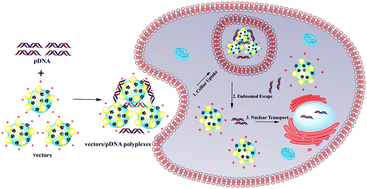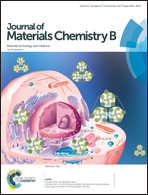Construction of core–shell tecto dendrimers based on supramolecular host–guest assembly for enhanced gene delivery†‡
Abstract
Design of dendrimer-based nanoarchitectures for enhanced gene delivery still remains a great challenge. Here, we report the design of core–shell tecto dendrimers using a supramolecular assembly approach for enhanced gene delivery applications. Firstly, β-cyclodextrin (CD)-modified generation 5 (G5) poly(amidoamine) (PAMAM) dendrimers (G5-CD) and adamantine (Ad)-modified generation 3 (G3) PAMAM dendrimers (G3-Ad) both having amine termini were synthesized. Through the supramolecular recognition of CD and Ad, G5-CD/Ad-G3 core–shell tecto dendrimers with a G5 core and G3 shell were formed. The formed G5-CD/Ad-G3 core–shell tecto dendrimers with a size of 8.4 nm possess good monodispersity, well-defined three-dimensional structure, and quite low cytotoxicity. Importantly, with the abundant amines on the surface, the core–shell tecto dendrimers are able to transfect the luciferase (Luc) gene with an efficiency 20 times and 170 times higher than the G5-CD and G3-Ad dendrimers, respectively. The higher gene transfection efficiency can also be qualitatively confirmed by transfection of plasmid DNA encoding enhanced green fluorescence protein. Our results suggest that the developed G5-CD/Ad-G3 core–shell tecto dendrimers may be used as a promising vehicle for enhanced gene transfection applications.



 Please wait while we load your content...
Please wait while we load your content...